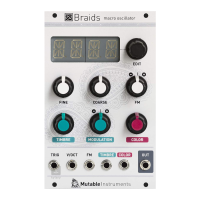VOWL, VFOF
Both models synthesize vowel sounds. VOWL is a faithful recreation of early computer
speech synthesis programs. VFOF uses a simplified version of Rodet’s FOF synthesis
technique. Both have the same control layout: TIMBRE controls the vowel, morphing
between a, e, i, o, u. COLOR shifts the formants in frequency. Main oscillator frequency and
COLOR can be used altogether to simulate age and gender transformations.
FM, FBFM, WTFM
Three flavors of 2-operator phase-modulation synthesis. TIMBRE controls the modulation
amount. COLOR controls the relative frequency interval between modulator and carrier. FM
is a well-behaved implementation. FBFM uses feedback from the carrier to itself to produce
harsher tones. WTFM uses two feedback paths, from carrier to modulator and carrier to itself
to achieve droning, unstable tones.
BELL
This model established by Risset uses additive synthesis to recreate the tone of a bell.
TIMBRE controls the damping of the sound; and COLOR the inharmonicity of the sound.
This model needs to be “excited” by a trigger signal (or raising edge of a gate signal).
DRUM
This variant of the *BELL* model uses different parameters (partials frequencies and
amplitudes) to generate a sound reminiscent of a metallic drum. TIMBRE controls the
damping and COLOR the brightness.
PLUK
Raw plucked string synthesis. TIMBRE controls the damping, COLOR the plucking position.
This model needs to be “excited” by a trigger signal.
BOWD
Bowed string modeling. TIMBRE controls the friction level, COLOR the bowing position. A
trigger or gate signal is required. Note that this model does not include a body filter – which
would be necessary to simulate an actual string instrument.
BLOW, FLUTE
Reed or flute instrument model. TIMBRE controls the air pressure, COLOR the geometry of
the instrument. Note that this model does not include a filter – which would have been
necessary to simulate an actual instrument.
WTBL
WTBL is a classic implementation of wavetable synthesis. TIMBRE sweeps the wavetable,
and COLOR selects one of the 20 wavetables to play with. The waveforms are interpolated
when traveling through a wavetable, but not when switching from one table to another.
WMAP
WMAP is a two-dimensional implementation of wavetable synthesis. 256 waveforms have
been laid out in a 16×16 grid, so that adjacent waveforms are similar sounding. The TIMBRE
parameter scans the table in the X direction, and the COLOR parameter scans the table in
the Y direction, with smooth interpolation across the two directions.

